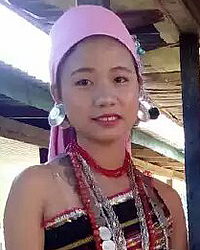Anu in Myanmar (Burma)

Photo Source:
Asia Harvest-Operation Myanmar
|
Send Joshua Project a map of this people group.
|
| People Name: | Anu |
| Country: | Myanmar (Burma) |
| 10/40 Window: | Yes |
| Population: | 700 |
| World Population: | 700 |
| Primary Language: | Chin, Anu-Khongso |
| Primary Religion: | Christianity |
| Christian Adherents: | 90.00 % |
| Evangelicals: | 30.00 % |
| Scripture: | New Testament |
| Ministry Resources: | Yes |
| Jesus Film: | No |
| Audio Recordings: | Yes |
| People Cluster: | Kuki-Chin-Mizo (Zo) |
| Affinity Bloc: | Tibetan-Himalayan Peoples |
| Progress Level: |
|
Identity
Although linguists have combined the two tribes into a single Anu-Khongso language group, each people maintains a distinctive identity and has been profiled separately in this book. The Anu are one of 61 different tribes in Myanmar belonging to the large Chin cluster. In spite of their recognized cultural similarities, each Chin tribe retains its own history and ethnic identity.
Location: The 700 members of the Anu tribe inhabit eight villages in Paletwa Township, which sits within the Matupi District in the southernmost part of Chin State. Paletwa is located just 11 miles (18 km) from the Bangladesh border in far western Myanmar, and it also shares a border with the Indian state of Mizoram (one of only two international land borders between the two countries). The Anu villages are found east of the Kaladan River, which is west of Kyauk Pan Daung, a distinctive flat-topped, rocky mountain that serves as a landmark in the region, while most Khongso villages are situated northwest to west of the mountain along the banks of the Michaung River. The Anu are located wholly in Paletwa Township, while the Khongso also inhabit part of Sami Township.
Language: While it is true that Anu is closely related to Khongso, the two are very different from other Chin languages. Anu and Khongso are part of the Ngwi-Burmese branch of the Tibeto-Burman linguistic family, while almost all other Chin languages are part of the Kuki-Chin branch. Consequently, Anu-Khongso reportedly shares only 23% to 37% lexical similarity with neighboring Chin languages. While the Anu language enjoys widespread use in villages, in mixed families the Khumi and Eastern Khumi languages are often spoken, and Rakhine and Burmese are increasingly used by Anu youth.
History
The Anu and Khongso are believed to have migrated to their present locations more than two centuries ago. The civil war currently engulfing Myanmar has affected the Anu area, with men being forcibly conscripted to fight in the conflict. The Arakan resistance army seized control of Paletwa in January 2024, striking a blow to the Burmese regime and causing the nearby Indian border to close. Approximately half the population of Paletwa fled into the surrounding jungle as the Burmese air force conducted numerous airstrikes on the town, some of which included the use of chemical gas bombs.
Customs
Most Anu people are hardworking agriculturists, growing bananas, oranges, mangoes, rice, sesame seeds, chili, and ginger. Others are engaged in fishing and hunting, although the number of wild animals has sharply decreased in recent decades due to expanding human habitations and shrinking forests. An Indian initiative to build a new road from Mizoram through Paletwa and beyond into central Myanmar promised to open the area to the outside world and boost the local economy, but work on the project has ground to a complete halt because of the armed conflict in the area.
Religion
Almost all Anu families are Christians today, with only a small number of people holding to the animistic beliefs of their forefathers. Others have adopted Buddhism after being influenced by their Burmese and Rakhine neighbors. Churches are found in every Anu village today, with many believers thankful to God for the truth and light His Word has brought into their communities.
Christianity
Despite their small population, at least seven Christian denominations have established churches among the Anu and Khongso people. Portions of the Bible were translated into Anu in 2014 using the Roman script, and work is underway on the New Testament, after the Khongso New Testament was published separately in 2022. Having their own Scriptures will boost the faith of many Anu believers who have previously used Khumi and Burmese Bibles, which they couldn't understand.